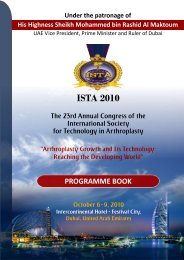ista 2007 program at a glance
ista 2007 program at a glance
ista 2007 program at a glance
Create successful ePaper yourself
Turn your PDF publications into a flip-book with our unique Google optimized e-Paper software.
B14-1<br />
A NEW DESIGN OF ANKLE PROSTHESIS TARGETING LIGAMENT ISOMETRY: INTRA-<br />
AND POST-OPERATIVE VALIDATION MEASUREMENTS<br />
Leardini Alberto, C<strong>at</strong>ani Fabio, Romagnoli M<strong>at</strong>teo, Bianchi Loris, Miscione Maria Teresa, Giannini Sandro<br />
Corresponding Author: Alberto Leardini<br />
Istituti Ortopedici Rizzoli, Movement Analysis Lab, Bologna , 40136, Italy<br />
Ph: ++39 051 6366522<br />
Fax: ++39 051 6366561<br />
Email: leardini@ior.it<br />
Total ankle (TAA) is still not as s<strong>at</strong>isfactory as total hip and total knee arthroplasty. For TAA to be considered a<br />
valuable altern<strong>at</strong>ive to ankle arthrodesis, an effective range of mobility must be recovered. The disappointing clinical<br />
results of the current gener<strong>at</strong>ion of TAA are mostly rel<strong>at</strong>ed to poor understanding of the an<strong>at</strong>omical structures<br />
guiding joint mobility. A new design has been developed by these authors, potentially able to restore physiologic<br />
ankle mobility and a n<strong>at</strong>ural rel<strong>at</strong>ionship between the implanted components and the retained ligaments.<br />
According to extensive prior research, the new design fe<strong>at</strong>ures a spherical convex tibial component, a talar component<br />
with radius of curv<strong>at</strong>ure in the sagittal plane longer than th<strong>at</strong> of the n<strong>at</strong>ural talus, and a meniscal component<br />
fully conforming to these two. In the sagittal plane, the shapes of the tibial and talar components are comp<strong>at</strong>ible<br />
with a four-bar linkage model formed by the calcaneofibular and tibiocalcaneal ligaments. After computer-based<br />
modelling and preliminary observ<strong>at</strong>ions in trial implant<strong>at</strong>ion on an<strong>at</strong>omical prepar<strong>at</strong>ions, 75 p<strong>at</strong>ients were implanted<br />
in the period July 2003 – May <strong>2007</strong>, with mean age 62 years (range 37 – 80), mean follow-up 18 months<br />
(range 1 – 46). For the meniscal bearing to slide smoothly on both the components, a special oper<strong>at</strong>ive technique<br />
was designed together with relevant instrument<strong>at</strong>ion in order for the three components to be implanted in an exact<br />
position also with respect to the retained ligaments. This was achieved by ensuring th<strong>at</strong> a constant gap is maintained<br />
between the tibial and the talar components throughout the flexion arc. The AOFAS score system was used<br />
to assess p<strong>at</strong>ient outcome <strong>at</strong> 3, 6, 12, 24, 36 month follow-ups.<br />
Intra-oper<strong>at</strong>ively, the components se<strong>at</strong>ed properly onto the prepared osteotomies. Over the entire motion arc, the<br />
prosthesis maintained complete congruence <strong>at</strong> the two articul<strong>at</strong>ing surfaces of the meniscal bearing which moved<br />
considerably antero-posteriorly. Range of dorsi- and plantar-flexion improved from respectively 0.4 and 15.3 preop<br />
to 10.1 and 24.2 post-op, maintained <strong>at</strong> the follow-ups. Radiographs <strong>at</strong> maximal dorsiflexion and maximal plantar<br />
flexion and fluoroscanning confirmed the meniscal bearing moves anteriorly during dorsiflexion and posteriorly<br />
during plantarflexion, over a d<strong>ista</strong>nce of 2 to 11 mm. Frontal and l<strong>at</strong>eral radiographs of all p<strong>at</strong>ients <strong>at</strong> all follow-ups<br />
showed good alignment of the components, and no signs of radiolucency or loosening. The mean AOFAS score<br />
was observed to go from 40.6 pre-op to 78.5 <strong>at</strong> last follow-up.<br />
Because the meniscal bearing moved in the direction and approxim<strong>at</strong>ely for the d<strong>ista</strong>nce predicted by computerbased<br />
models, physiological roles of the ligaments must have been restored, i.e. controlling joint mobility by isometric<br />
fibre rot<strong>at</strong>ions and assuring joint stability by appropri<strong>at</strong>e load res<strong>ista</strong>nce. As full conformity of the three<br />
prosthesis components was observed over the entire motion arc, it is encouraged also the prospect of minimizing<br />
wear of these components. Slight misplacement of the bone-anchored components did not affect considerably these<br />
observ<strong>at</strong>ions. The s<strong>at</strong>isfactory though preliminary observ<strong>at</strong>ions both intra- and post- oper<strong>at</strong>ively from this novel<br />
TAA encourage continu<strong>at</strong>ion of the implant<strong>at</strong>ion.<br />
212
















